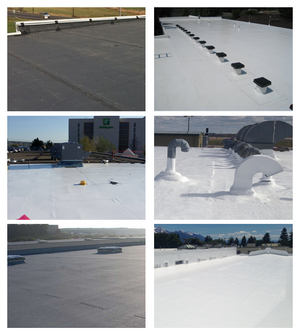You may ask, “Why have a flat roofing on a building?” That’s a great concern! Flat roofs are absolutely nothing brand-new, nor are some of the tested materials that cover these often-expansive roofings such as those found on factories, warehouses, big and little box stores, apartment or condo buildings, large public structures and schools/universities.
Let’s explore the following subjects as they connect to the primary low slope roof: Item features, advantages and differences Accessory alternatives Overall maintenance and guarantees After a recent evaluation of the Manual of Low-Slope Roof Systems * (hereafter referred to as the Manual), this handbook will be referenced throughout this article.
( Cock) Fricklas and C.W. Griffin, this is one of the most comprehensive written guides to business flat roof. The (NRCA) offers a robust website and resources tailored for specialists about everything roof associated. Their easy-to-navigate website supplies an extensive overview of products, applications, courses and other resources for specialists and building specialists.
The 2015-2016 NRCA Market Study http://www.nrca.net/2016-market-survey programs that roof system types throughout the U.S. continue to show the current patterns in low slope industrial roofing applications. The study results show TPO as the low-slope market leader, gathering a 40 percent share of the brand-new building market and 30 percent of the reroofing market.
In third location is Mod Bit at 12.4 percent of the brand-new construction market and 14 percent of the reroofing market. Market share for these and other system solutions follow by portion in the chart below: From here, we’ll examine these low slope roof system choices in the chart, from those with the tiniest market share to the best.

Liquid used membrane systems need strenuous preparation of the substrate, which must be dry and dust-free with patched cracks. While liquid applied coatings are highly flexible, self-flashing and quickly used to contoured surface areas, they have low permeability and require consistent thickness. The NRCA provides an online course Design Fundamentals for Roofing Efficiency: Liquid-applied Roofing System Membranes for a thorough take a look at liquid-applied roofing system membrane options.
Lead roofing later signed up with bronze as a popular option for cathedrals and castles throughout Europe throughout middle ages times. Much of today’s low slope metal roofs are made from corrugated galvanized steel a steel sheet covered with zinc. Copper, aluminum, stainless-steel and tin likewise are utilized in commercial metal roof applications.
Furthermore, metal roofs can withstand high winds and are mainly impact resistant. Nevertheless, the investment for a metal roofing service likely will be much greater upfront than other flat roof services. The Metal Construction Association (MCA) provides resources for those thinking about finding out more about using metal as a low slope roofing option.
To help structure professionals, the MCA performs numerous technical research studies and research tasks in collaboration with member and market partners designed. These complimentary resources consist of publications, white papers, manuals and reports. Low slope structural metal roof is frequently called standing seam roof and includes interlocking panels that run vertically along the roofing surface area.

Some metal roof used on low slope applications needs machine seaming throughout installation to ensure a leak-proof seal. A seaming apparatus is just rolled along the panels to crimp the panel joints together. A standing seam design assures sufficient draining pipes from rain and snow, efficiently removing ponding, leaks and related problems.

This may lead to a longer life expectancy and low yearly operating expense. In retrofit projects, a sub-framing system is connected to the existing flat roof surface area to offer a minimum:12 roofing pitch. Choices for the restoration of a metal roofing system surface consist of acrylic coatings made of polymers that cure to form a resilient, constant elastomeric membrane over the surface of the metal roofing and can be contributed to metal roof systems to resolve your building’s specific needs around waterproofing, rust and UV protection.
Acrylic coatings are water-based, non-flammable and emit no harmful fumes. These systems can withstand the most typical kinds of roof risks, consisting of ultraviolet light, temperature level extremes, mildew, normal foot traffic and structure movement. While not on the list in regards to market share, another roof system must be pointed out the vegetative or “green” roof.
Vegetative roofs can successfully supply a helpful means for storm water control. Remember, a roofing membrane as a base to the system is extremely important to preserving the roofing system’s integrity and water tightness. To learn more on vegetative roofing systems, make sure to go to Green Roofs for Healthy Cities.
ncG1vNJzZmirY2Ourq3ZqKWar6NjsLC5jqumqJ6Zo7RuscOgnLCZpJq%2FcLLLmqtmqp%2Bks26%2BxKmYoqpdmbKtwM6nmGaenGO1tbnL